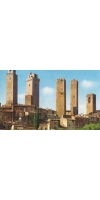Wine from Signano

Signano Estate
San Gimignano rises on a hill 384 mt high and dominates the Elsa valley with the skyline of its 13 towers. The Manhattan like sky scrapers were built between the 12 and the 13th century. Not unlike today, the towers were a symbol of the economic powers of the noble families of that region.The Vernaccia vine has been growing in the charming hillsides which surround this middle-age town since 1200 ad. This is the vine for the production of Vernaccia di San Gimignano, which for centuries has tempted popes, honored magnificent feasts of the renaissance princes, and has won a growing fame over time.
Because of Vernaccia di San Gimignano’s ancient tradition and unquestionable quality, the wine was the first to be awarded DOC recognition in 1966. Since 1993 the Vernaccia di San Gimignano has entered into the category of DOCG recognition. The Signano Estate began its activity in 1961, when the Biagini Family purchased a small plot of land of 4.5 Ha. in Signano. Prior to the planting of his first vineyard in Vernaccia, Ascanio earned a reputation as bailiff to a land-owner from Florence where he maintained a broad reputation for his knowledge of the vineyards and wines of the region. The first cellar was built in 1966 and the lands adjacent to it were purchased in the following years for vineyards.
The leased vineyards and olive groves create the present Estate that covers approximately 30 Ha. Most of the Estate is cultivated with Vernaccia, but 3 Ha. are dedicated to the production of Vin Santo (dessert wine) and 6 additional Ha. are used for the production of extra virgin olive oil. Today, the cellar has a capacity of 205,000 litres with an additional ninetyfive 100 litre oak casks for the maturation of Vin Santo.
No products found
- back
Selected Options
Wineries
Categories
Pricing
Countries
Regions
Grape Types
Wineries
Organic/Free Shipping
All older vintage wines have been purchased from a single collectors cellar. Pictures can be requested before shipment.
Pago de Carraovejas Cuesta Liebres is made from 100% Tinto Fino. The plot is located on a terraced hillside located at 900 m above sea level with slopes that range between inclines of 30% and 40%. Red cherry color with purple hues. Ripe fruit aromas, vanilla notes. Suave and unctuous in the mouth. A strong and noble character.
The harvest is carried out by hand using small crates and after passing through a refrigerated container it is transferred into tanks via gravity. The alcoholic and malolatic fermentation is carried out in small French “Haute Futaie” Oak casks with unique and original local yeasts and fermenting bacteria from the vineyard itself, to bring out the very best of the terroir, respecting the uniqueness of each and every vintage. Clarified with egg whites and bottled by gravity with natural cork stoppers.
Review:
"From the vineyard of the same name, the 2021 Cuesta De Las Liebres is a knockout, from a hillside vineyard of terraced vines. Aged 24 months in French oak, the first year in new, the second in second-use, all fine-grained, and bottled in June 2024, the tannins are well-integrated and dusty, nearly chalky. It’s truly a beautiful expression of variety, vintage, and site, reaching perfection in its fine-tuned, full-bodied layers of rich cassis, oak spice, and even a touch of garrigue. There’s lovely acidity throughout that brightens the palate, with beguiling notes of violet that never fade away. It’s a seamless, polished, gorgeous wine that will be hard to resist, though aging will continue to see it melt into one over the next 15-18 years. - Virginie BOONE"
- Jeb DUNNUCK (August 2025), 100 pts




